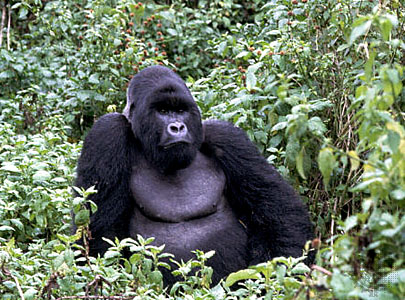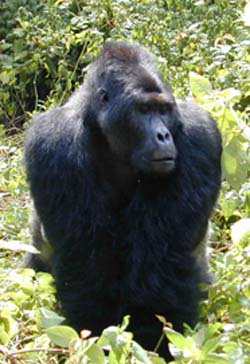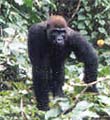
August 5, 2008
For years cryptozoological researchers have been questioned and criticized for estimating the population of large hairy unknown primates in North America, most often called Bigfoot and Sasquatch.
Now comes news that the world is excited by the findings from the Wildlife Conservation Society that the western lowland gorilla subspecies is estimated to be 125,000 animals strong.
Xihuanet news is reporting that wildlife researchers on Tuesday, August 5, 2008, announced a major increase in the population of lowland gorillas after a new census tallied more than 125,000 in an 18,000-square-mile (47,000-square-kilometer) deeply forested area of the Republic of Congo.
Estimates from the 1980s had suggested fewer than 100,000 of the great apes had survived and many experts believed these numbers had been cut nearly in half by disease and hunting.
“This is a very significant discovery because of the terrible decline in population of these magnificent creatures to Ebola and bush meat,” said Emma Stokes, one of the research team.
How did they estimate the population, you ask? The researchers in the central African nation of Republic of Congo came up the population figures by counting the sleeping “nests” gorillas make. They reported that the gorillas themselves are too reclusive and shy to count individually.
Craig Stanford, professor of anthropology and biology at the University of Southern California, said he is aware of the new study. “If these new census results are confirmed, they are incredibly important and exciting, the kind of good news we rarely find in the conservation of highly endangered animals.”
But I have to raise the skeptical notion that this figure could be greatly overblown. Gorillas do not merely make a nest and stay there for life. Yes, while they sometimes re-use nests, they also move on and build new nests.
Would you estimate the human population (taking into account the homeless) by counting the number of homes in an area? How would you estimate the multiple users of one dwelling? The empty houses? The moving of one family to other houses?
I question the methodology (as it is so casually explained in the mass media) in this gorilla study, and wonder if the under-estimates in the Sasquatch numbers might be more on-target than this “exciting news” on a massive population explosion among the western lowland subspecies of gorilla. Counting nests to come up with a firm overall population figure seems, well, a bit shaky.
Western lowland gorillas are one of four gorilla subspecies, which also include mountain gorillas, eastern lowland gorillas and Cross River gorillas. (Some dispute exists about whether the mountain gorilla may be a full species, not a subspecies.) All are labeled either endangered or critically endangered by the International Union for Conservation of Nature.

Mountain gorillas have coloration and facial features that are quite different from the lowland gorillas (western, eastern, Cross River, and Grauer’s).

Grauer’s gorilla, which are said to be a subspecies of the eastern lowland, although, of course, the eastern lowland gorilla is already a subspecies.

Eastern lowland gorilla features a distinctive red crown, often seen in zoos).

Western lowland gorillas also show the red crown.

With only 200 in their entire population, the Cross River gorilla is rarely photographed in the wild.

Closeup of the Cross River gorilla’s face.

It is a common public misconception that older silverback males are only found among the mountain gorillas. This is a western lowland gorilla.

Some rather unique color phases are found among gorillas, such as this “browning out” in this male apparent western lowland zoo specimen.
What is also intriguing, of course, is the appearance of a definitely pointed head, much as described from the sightings of some Yeti and Sasquatch.
But not for the Bili ape.
About Loren Coleman
Loren Coleman is one of the world’s leading cryptozoologists, some say “the” leading living cryptozoologist. Certainly, he is acknowledged as the current living American researcher and writer who has most popularized cryptozoology in the late 20th and early 21st centuries.
Starting his fieldwork and investigations in 1960, after traveling and trekking extensively in pursuit of cryptozoological mysteries, Coleman began writing to share his experiences in 1969. An honorary member of Ivan T. Sanderson’s Society for the Investigation of the Unexplained in the 1970s, Coleman has been bestowed with similar honorary memberships of the North Idaho College Cryptozoology Club in 1983, and in subsequent years, that of the British Columbia Scientific Cryptozoology Club, CryptoSafari International, and other international organizations. He was also a Life Member and Benefactor of the International Society of Cryptozoology (now-defunct).
Loren Coleman’s daily blog, as a member of the Cryptomundo Team, served as an ongoing avenue of communication for the ever-growing body of cryptozoo news from 2005 through 2013. He returned as an infrequent contributor beginning Halloween week of 2015.
Coleman is the founder in 2003, and current director of the International Cryptozoology Museum in Portland, Maine.
Filed under Bigfoot, Breaking News, Cryptomundo Exclusive, Cryptotourism, CryptoZoo News, Cryptozoologists, Cryptozoology, Pop Culture, Reviews, Sasquatch, Weird Animal News